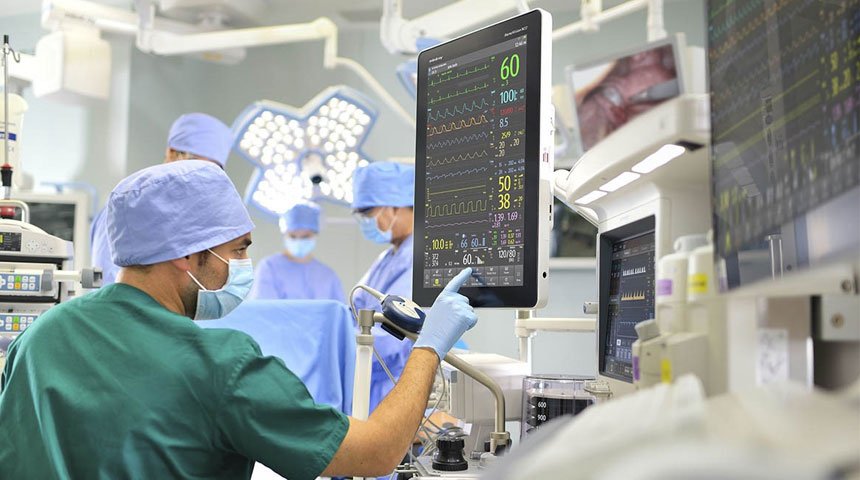Besides advances in medical equipment and medicine, another technological breakthrough is transforming healthcare: hospital automation.
We all want greater efficiency and effectiveness in healthcare. We all want to use the most advanced systems and strategies available. And we all desire consistently excellent outcomes.
In the healthcare sector, automation might look like a daily batch of text messages reminding patients of their appointments the next day. Or automation might trigger a database that detects and alerts doctors about known contraindications and drug interactions.
In this article, we will review some of the benefits of healthcare automation by following a patient during a hospital stay.
Our patient is Gary, a 43-year-old man. He arrived at the emergency room with swollen glands in his neck. Gary had a tooth extracted four days earlier and noticed a small swelling a few hours after the surgery. The swelling slowly spread and was now pressing on his throat.
With Gary’s help, we will experience healthcare automation from the perspective of four groups:
Patients
Physicians
Administrative support staff
Organizations
Shortly after Gary arrived at the emergency room, the assistant ordered a head and neck CT scan. When the EHR received the results, it immediately forwarded them via a secure text message to the treatment team.
The CT scan showed an abscess. The assistant used her mobile phone to access the hospital’s Clinical Collaboration & Communication (CC&C) system, sending a consultation request to the Oral Surgery department. Two minutes later, the on-call oral surgeon reviewed the CT scan and recommended an incision to drain the abscess.
As soon as an operating room became available, transport took Gary to surgery. Just as Gary arrived in the OR, he said his throat was closing and that he wouldn’t be able to breathe much longer. Seconds later, upon reaching the operating table, a surgeon intubated Gary, made an incision, and inserted a Penrose drain to remove the abscess.
After a short stay in the post-anesthesia care unit (PACU), Gary was admitted for 24 hours to receive antibiotics and monitoring.
Twenty minutes after Gary’s hospitalization, he felt his body heating up rapidly, resulting in a fever of 102°F. Knowing this was a dangerous situation, he spoke to the Amazon Alexa unit next to his bed, expressing urgent concerns about his rapidly rising body temperature.
Thirty seconds later, a nurse arrived to assess Gary’s condition, and within a minute, began cooling his body with an electric fan and damp towels.
Later that afternoon, during a routine vital signs check, a nursing assistant noticed a suspicious mole on Gary’s arm. The assistant reported it to the nurse, who ordered a dermatology consultation. The dermatologist sent an image of the mole to their Mole database, which correctly identified an early-stage basal cell carcinoma. The dermatologist prescribed an anti-tumor cream and told Gary he would not need further treatment.
After a shift change, Gary’s new nurse reviewed his ECG results from several hours earlier and noticed an abnormality. After consulting with Cardiology and discussing it with Gary’s PCP, the three doctors agreed that Gary should wear a small mobile heart monitor for two weeks. They assured Gary he wouldn’t have to cancel his upcoming out-of-state trip. By leveraging information technologies such as remote patient monitoring (RPM) and secure cloud-based infrastructure, the device could report cardiac irregularities as long as Gary was within cellular signal range.
When Gary’s physician issued a discharge order, secure messages alerted every member of the discharge team and set their worklists. Forty minutes later, the CC&C system detected the completion of all discharge team tasks and automatically sent a message to Transport and Environmental Services. Less than two hours later, Gary was on his way home, and the CC&C system sent a discharge summary to his PCP.
This story shows us how automation in the healthcare industry can benefit patients, physicians, support staff, and organizations. We have seen many forms of automation, including:
Robotic process automation software
Wearable devices leveraging remote patient monitoring
Artificial intelligence applied to the diagnosis of moles and cardiac conditions
AI is just beginning to change the way doctors see, diagnose, treat, and monitor patients. The potential to save lives and money is tremendous; one report estimates that big data processing algorithms could save medicine and the pharmaceutical industry up to $100 billion annually as a result of AI-assisted efficiencies in clinical trials, research, and decision-making in the doctor’s office.
These developments are helpful, but they are also becoming essential. We face the challenge of continuing to provide quality healthcare with a healthcare workforce that is not growing as fast as the aging population. We will need more doctors, not fewer.
Hospital automation provides the necessary answers to improve efficiency and productivity, enabling fewer people to do more work. With technology that accelerates and even takes over some of our human tasks, we can keep pace with society’s growing healthcare needs.


